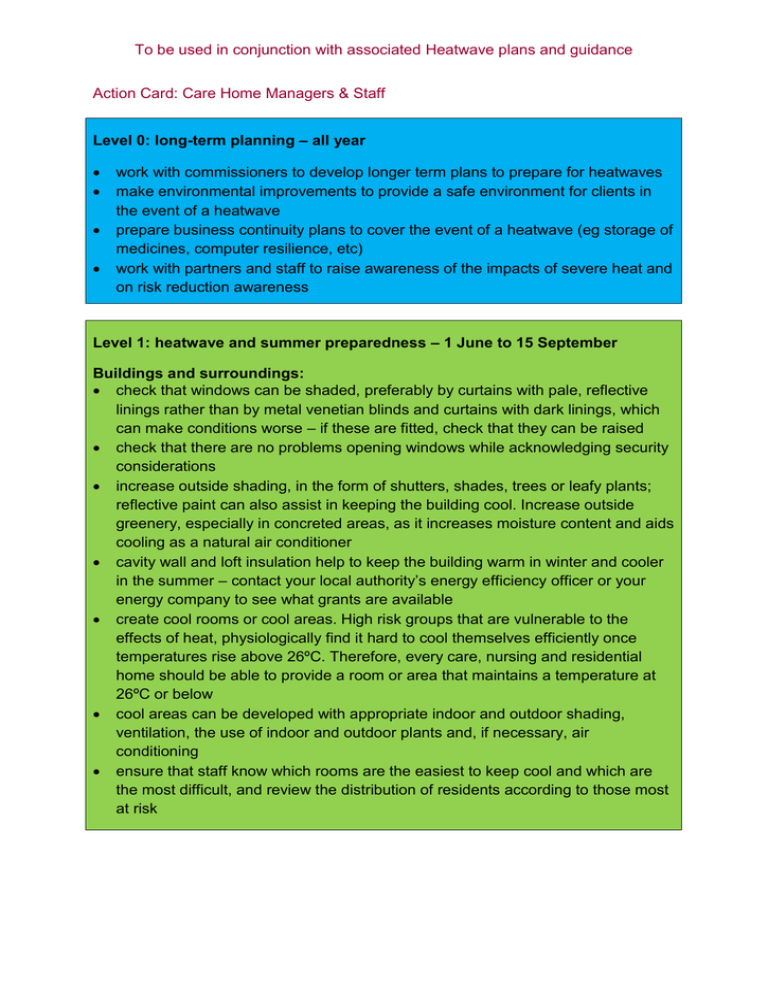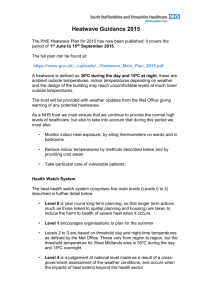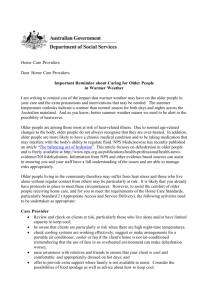To be used in conjunction with associated Heatwave plans and
advertisement

To be used in conjunction with associated Heatwave plans and guidance Action Card: Care Home Managers & Staff Level 0: long-term planning – all year work with commissioners to develop longer term plans to prepare for heatwaves make environmental improvements to provide a safe environment for clients in the event of a heatwave prepare business continuity plans to cover the event of a heatwave (eg storage of medicines, computer resilience, etc) work with partners and staff to raise awareness of the impacts of severe heat and on risk reduction awareness Level 1: heatwave and summer preparedness – 1 June to 15 September Buildings and surroundings: check that windows can be shaded, preferably by curtains with pale, reflective linings rather than by metal venetian blinds and curtains with dark linings, which can make conditions worse – if these are fitted, check that they can be raised check that there are no problems opening windows while acknowledging security considerations increase outside shading, in the form of shutters, shades, trees or leafy plants; reflective paint can also assist in keeping the building cool. Increase outside greenery, especially in concreted areas, as it increases moisture content and aids cooling as a natural air conditioner cavity wall and loft insulation help to keep the building warm in winter and cooler in the summer – contact your local authority’s energy efficiency officer or your energy company to see what grants are available create cool rooms or cool areas. High risk groups that are vulnerable to the effects of heat, physiologically find it hard to cool themselves efficiently once temperatures rise above 26ºC. Therefore, every care, nursing and residential home should be able to provide a room or area that maintains a temperature at 26ºC or below cool areas can be developed with appropriate indoor and outdoor shading, ventilation, the use of indoor and outdoor plants and, if necessary, air conditioning ensure that staff know which rooms are the easiest to keep cool and which are the most difficult, and review the distribution of residents according to those most at risk To be used in conjunction with associated Heatwave plans and guidance indoor thermometers should be installed in each room in which vulnerable individuals spend substantial time (bedrooms and living and eating areas) – during a heatwave, indoor temperatures should be monitored regularly electric fans may provide some relief, if temperatures are below 35ºC (note, use of fans: at temperatures above 35ºC fans may not prevent heat-related illness. Additionally fans can cause excess dehydration; the advice is to place the fan at an appropriate distance from people, not aiming it directly on the body and to have regular drinks – this is especially important in the case of sick people confined to bed) Working arrangements: ensure business continuity plans are in place and implement as required (sufficient staff must be available so that appropriate action can be taken in the event of a heatwave) get extra help from relatives of residents and volunteers provide an email address to local authority/NHS emergency planning officers, to facilitate the transfer of emergency information identify cool areas in the care home increase awareness of staff to heat-related illness and health protection measures Facilities: check that you have an adequate supply of fans and water sprays – install thermometers check that water and ice are widely available – ensure that you have a supply of oral rehydration salts, orange juice and bananas to help maintain electrolyte balance for those on diuretics arrange for cold drinks to be distributed regularly in the event of a heatwave plan to adapt menus to cold meals (preferably with a high water content, such as fruit and salads) in consultation with residents Residents: make sure you know who is most at risk – ask primary care staff if you are unsure and record it in their individual care plans ensure that you have protocols to monitor residents most at risk and to provide additional care and support (room temperature, body temperature, pulse rate, blood pressure and dehydration will need to be monitored) ask the GPs of at-risk residents about possible changes in treatment or medication in the event of a heatwave and review residents on multiple medications check that residents have light, loose-fitting cotton clothing to wear be aware that plastic pads and mattresses can be particularly hot during a heatwave To be used in conjunction with associated Heatwave plans and guidance Level 2: heatwave is forecast – alert and readiness 60% risk of heatwave in two to three days identify high-risk residents/patients if temperatures exceed 26ºC, high-risk individuals should be moved to a cool area that is 26ºC or below – for patients who can’t be moved, or for whom a move might be too disorienting, take actions to cool them down (eg liquids, cool wipes) and enhance surveillance check local weather forecasts on the radio, news, websites (eg www.metoffice.gov.uk) or paper check that staff, and others such as volunteers, know what to do during a heatwave suggest that all residents consult their GP about possible changes to their treatment and/or medication; consider prescribing oral rehydration salts for those on high doses of diuretics check indoor temperatures are recorded regularly during hottest periods in all areas where patients reside communicate alerts to staff and make sure they are aware of heatwave plans prepare cool areas and provide regular wet towels and cool foot baths ensure sufficient staffing Level 3: heatwave action – temperature reached in one or more Met Office National Severe Weather Warning Service regions Try to keep the care home as cool as possible: ensure you have taken the steps outlined above in Levels 1 and 2 activate plans to maintain business continuity – including a possible surge in demand for services increase outside shading – spraying water on the ground outside helps to cool the air (avoid creating slip hazards, check local drought water restrictions before using hosepipes) keep curtains and windows closed while the temperature outside is higher than it is inside once the temperature outside has dropped lower than the temperature inside, open the windows - this may not be until very late at night or the early hours of the morning discourage residents from physical activity and going out during the hottest part of the day (11am to 3pm) check indoor temperatures are recorded regularly during the hottest periods for all areas where patients reside ensure staff can help and advise clients and patients To be used in conjunction with associated Heatwave plans and guidance make the most of cooler night-time temperatures to cool the building with ventilation reduce internal temperatures by turning off unnecessary lights and electrical equipment consider moving visiting hours to mornings and evenings to reduce afternoon heat from increased numbers of people Monitor residents: check body temperature, heart and breathing rates, blood pressure and hydration levels watch for any changes in behaviour, especially excessive drowsiness watch for signs of headache, unusual tiredness, weakness, giddiness, disorientation or sleeping problems Reduce the health risks of heat: encourage residents to remain in the coolest parts of the building as much as possible move residents so that each spends time in the cool room/area (below 26ºC) – give priority and extra time to high-risk residents or any showing signs of distress (including increased body temperature); for patients who can’t be moved, or for whom a move might be too disorienting, take actions to cool them down (eg liquids, cool wipes) and enhance surveillance monitor residents’ fluid intake, providing regular cold drinks, particularly if they are not always able to drink unaided; remember the importance of increasing fluid intake during periods of high temperature to reduce the risk of blood stream infections caused by Gram-negative bacteria. Oral rehydration salts may be suggested for those on high doses of diuretics; bananas, orange juice and occasional salty snacks can also help replace salts lost due to sweating advise residents to avoid caffeine (coffee, tea, colas), very sweet drinks and alcohol encourage residents to wear light, loose cotton clothes to absorb sweat and prevent skin irritation regularly sprinkle or spray cool water on exposed parts of the body – a damp cloth on the back of the neck helps with temperature regulation arrange cool showers or baths if possible To be used in conjunction with associated Heatwave plans and guidance Level 4: major incident – emergency response Central government will declare a Level 4 alert in the event of severe or prolonged heatwave affecting sectors other than health and if requiring coordinated multiagency response. All existing emergency policies and procedures will apply. All Level 3 responsibilities will continue. Emergency treatment If you suspect someone has heatstroke, call 999. While waiting for the ambulance: take the person’s temperature if possible, move them somewhere cooler cool them down as quickly as possible by giving them a cool shower sprinkling them with water or wrapping them in a damp sheet, and using a fan to create an air current encourage them to drink fluids, if they are conscious do not give them aspirin or paracetamol Further local advice & guidance is available at: www.somerset.gov.uk/heatwave Further national advice & guidance is available at: https://www.gov.uk/government/publications/heatwave-plan-for-england

